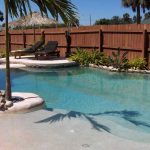CLEANING UP YOUR POOL WHEN MOTHER NATURES STRIKES
This past year has seen some unprecedented weather. Hurricanes and earthquakes occurring in areas not
accustomed. Tornadoes and snowstorms have occurred off season in other areas. Not to mention, increased
catastrophes such as tsunamis and volcanic eruptions making headlines. While it is likely you may not have
experienced many of these, Mother Nature can certainly reek havoc and your swimming pool could be in her
way. So how exactly do you get your pool up and running after such an event?
Swimming pools and spas that are open to the environment can become severely affected by storms,
floods, winds or more. The pool does need to be cleaned up before it can be used again. For bathers’
safety, the pool or spa should be isolated to not allow entry putting bathers in harm’s way.
First, it needs to be determined if the pool still has electricity being supplied to the filtration system. You
should contact your electric company if there is no power. You should be no means touch any live wires or
try to perform electrical work if you are not qualified to do so. Once a qualified person has confirmed
electricity is available, it is ok to begin clean up.
Obviously, all debris, dirt and objects that have entered the pool/spa need to be removed. It is best to
remove all large objects by hand or with the help of poles and nets. It is not suggested to use a robotic
vacuum cleaner to do the bulk of the pickup. The excess leaves will slow down and possibly impair the
operation of the vacuum. Also, be sure to empty all skimmer and pump baskets which likely will be clogged
with debris. It may be necessary to vacuum the pool to waste and add water, as to not stress the filtration
system and filter media.
Once all the debris is removed and the main drain is visible, you need to ensure that the main drain cover is
in place securely and intact. Regardless of weather, main drain covers must always be secure, intact and
only removable with the use of a tool. If this is not the case, the pool/spa must be closed until the main
drain is intact and secure.
Once all items have been removed, the filtration system should be inspected to make sure it is working
properly. All components need to be intact and operational including piping, valves, pumps, filters, gauges,
heaters, chemicals feeders, etc. A qualified technician is recommended to make any needed repairs.
Finally, the water needs to be treated. All components of water chemistry will likely need to be addressed as
the addition of more water from such a weather event will affect the pool’s chemistry. It may be possible
that your water level is higher than normal. In this situation, it is recommended to shock/super chlorinate
the pool. Additionally if water clarity is an issue, a water clarifier or flocculants can be added. Additionally in
such circumstances, poor circulation and stagnant water can lead to increased growth of algae bacteria.
Thus, these additional treatments may also be required.
If draining is necessary, it is important to remember not to drain your pool unless it has a hydrostatic relief
valve. This valve prevents the pool from being popped out if the ground. With a weather catastrophe, the
ground will likely be more saturated than normal raising the water table in your area. Areas with higher
water tables are susceptible to the external pressure on the pool popping it out of the ground as water is
removed from the pool. If this is the case, a complete draining will not be possible. Also, pools with vinyl
liners should not be drained in their entirety as it affects the condition of the liner.
Before draining the pool, always contact the local water department make sure draining is permitted and
where to drain the pool water. Draining can be done through the use of portable pumps. Also, backwashing
the pool to waste can also speed up the draining process. If draining the pool, this is a ideal time to have an
acid wash performed on gunite pools. It is recommended to have an qualified service company perform the
acid wash. You can read more on how to perform an acid wash here.
It is always recommended to seek the help of professionals. Pool service companies, local health
departments and manufacturers can provide greatly needed advice, insight and help in your time of need.
This will ensure you can get your pool back up and running and enjoy your pool once again.
Basic Tips:
Pool Clean Up: Remove large twigs, branches and the bulk of leaves and debris with a leaf rake and
skimmer net. Use the automatic cleaners to pick up the fine dirt and debris. Remember to empty pump
baskets and skimmer baskets frequently.
Power Issues: Do not turn the power back on if the equipment was submerged by water. Have a pool
professional inspect your equipment to make sure it is safe to turn on.
Pool Water Chemistry: Make sure you bring have your water tested by a pool professional after the
storm determine how your water chemistry has been affected.
Barriers: Make sure all barriers including fences, gates, safety fencing, etc are intact and prevent a barrier
to access to your pool to prevent others from accessing your pool.
Standing Water: Remove any standing water from pool equipment and around your pool to prevent
mosquitoes from breeding.






